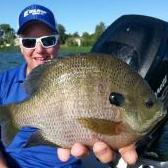Chasing Dogs Riding Bicycles
Chasing Dogs Riding Bicycles
Chasing Dogs Riding Bicycles
I woke up in a panic. I’ve had nightmares before but this one was different. You see no one was chasing me, I wasn’t falling from a high place and I wasn’t behind the wheel seeing headlights. I had just knocked off a bluegill at the bottom of the hole that I suspected was an honest two pounds. In a world where most anglers rarely find a one pound bluegill, this was a nightmare of epic proportions. Waking up safe and sound on top of the covers and coming to the realization that I had never hooked this fish was a huge relief. Fish of this caliber, while extremely rare, do exist beyond my unusual dreams. Legendary bluegill hunter, Bruce Condello, and his group of bluegill aficionado friends, had shirts made of dogs riding bicycles because honest three pound bluegills are about as common. Bruce specifically has five bluegills to his credit that went an honest three pounds in his home state of Nebraska. If we were to start a fantasy bluegill fishing league, another of my top draft picks would have to be Clayton Davis of North Dakota. Davis recently captured a 12” two pound specimen late ice this past winter and has many other large fish to his credit. While scarfing down a gas station burrito on the way home from chasing bluegills all day may have led me to strange dreams of massive pie plates, I wanted more. I wanted to know what it really takes to land a personal best this ice season. How do these anglers select lakes that have the capabilities to produce this caliber of bluegill? Does it relate to the genetics of the fish or is it simply a matter of finding over fed obese populations? What voodoo mind tricks are involved in finding dogs riding bicycles?
North Dakota angler, Clayton Davis, has really made a name for himself the past few seasons with his social media bluegill pictures. Living in an area where walleyes and perch reign as king, he has found populations of giant untapped bluegills. Davis has a system of finding lakes that have trophy potential and it starts with looking into state stocking reports. He explained to me that you not only need to check available data on bluegill populations but also try to locate lakes with large pike. Lakes that boast populations of large pike typically have a balanced population of bluegills. Balanced populations have the potential to grow large fish versus lakes that have over abundant populations of fish that will end up stunted. Lakes will only support so many inches of fish so these large predators are needed to keep the population in check and the size good.
After selecting lakes with high caliber potential, Davis begins his search. He notes that pencil reeds are paramount when searching out a new lake and big bluegills are usually in close proximity. He will start shallow and work his way through the mid depth weed flats out into the basin. During late ice, which he considers the best time to chase pie plates, he often finds giants in as shallow as three feet of water. Using the weed fishing mode on his Vexilar FLX-28 allows Davis to see his jig and approaching fish in this heavy cover. He explains that the weed mode drowns out clutter from the weeds and has been instrumental in his success. When he begins to find medium sized fish, he will often drill a large concentration of holes to circle that immediate area. This allows him to dissect the weed beds and find the best vantage points. Places for fish to ambush prey, while also providing cover from large pike, are going to hold the largest gills. He described that a sort of pecking order exists in the world of bluegills and big fish will take these prime locations and push smaller fish out into the fringe areas.
The founding father of modern ice fishing, Mr. Dave Genz, has been chasing high caliber bluegills since childhood. He likes to look for big bluegills in lakes that will sometimes experience a partial winter kill. Yes, you read that correct. This is a theory that has worked well for Genz over the years. It goes back to a lake only being able to support so many inches of fish. A partial winter kill will thin the lake enough for the remaining fish to thrive and grow large. In order for this to happen at least part of the lake has to be shallow limiting oxygen after the weeds die off mid-winter. This is one of the few events that can reverse the effects of lakes that house over abundant stunted populations.
Pursuing pie plate sized bluegills is my passion. I have spent countless hours milling over maps and lake data looking for the next lake that may produce a fish over 11”. I have found a few factors that I like to look for when trying new waters. The first would be current. Lakes that are connected by rivers and have some current running through them for whatever reason are always top producers. While I have not completely figured out the correlation, give this trick a try and I promise you won’t be disappointed. The second thing I like to look for is the presence of shrimp. Amphipods or shrimp are high calorie meals for bluegills and can bulk up fish faster than other invertebrates. If obese gills are on the docket this winter, find the lakes with shrimp and current.
The other piece of the puzzle is genetics. Male bluegills pass on genetics to their offspring. Just as my children will never be as tall as Shaqueille O’Neil’s children, 7” male gills do not have the proper genetics to produce 11” bulls. Bruce Condello, owner of the website bigbluegill.com, has his own strain of bluegill called Condello gills. He has created this strain on a private pond that he manages by netting the pond every year in October. By taking out all bluegills except the largest 1/10 of 1 %, he has created a sort of super strain that can grow to 10” in sixteen months. One thing this tells us is that when anglers sort to keep the largest bluegills as table fare, we are genetically making our bluegill populations smaller. It is important that the bluegill aficionado recognizes this and opts to release big bulls and instead harvest more abundant smaller fish.
When hunting down giant Nebraska bluegills on public water, Bruce likes to look for lakes that house large concentrations of juvenile largemouth bass. It goes back to the theory of lakes only being able to support so many inches of fish. According to Condello, largemouth bass in the 11” range are eating machines and keep populations balanced. This allows remaining bluegills enough food to pack on pounds. He also looks for lakes that have, what he describes as, high water quality. Lakes that have submergent vegetation, clear water and low nutrient loads are his top choices. Clear lakes have better sunlight penetration for weed growth. These lakes with rooted vegetation produce oxygen from the bottom up so fish don’t get stressed and can continue to feed even throughout difficult periods of the year. Lakes that are highly nutrient laden lack the sunlight penetration to grow deep rooted vegetation so oxygen comes from algae and can dip to low levels. He also noted the importance of appropriate sized invertebrates for the fish to feed on in the early stages. If another species strips out the 1 mm sized invertebrates, young bluegills must become risk takers, leaving the protection of the weeds in search of an open water food source. This often leads to them being eaten by bass. He believes that having enough of the correct sized invertebrates is more important than the amount of available spawning habitat in a particular lake. Avoiding lakes with small stunted populations is paramount. Lakes with an overabundance of weeds will foster small fish and stunted populations. Ideal waters are comprised of less than 10% weeds. Heavily weeded lakes will protect more bluegills from predation than the food source can support and the population will stunt. Condello’s best advice for an angler looking to ice a personal best this winter is to first, find lakes that have big bluegills and second, sort through a lot of fish. Visualize the items that a large bluegill may eat that a medium sized bluegill cannot. Big bluegills have bigger mouths than their medium sized counter parts so bigger baits are often necessary. Pay attention to the depth that the bigger fish are using. Don’t be afraid to leave medium sized fish to search out giants.
The ice season is finally upon us and with it brings an opportunity to spend time with friends and family on the hard water again. Whether you or I ice a personal best or not this season, the charm is what is elusive but attainable, a perpetual series of occasions for hope (John Buchan). I guess I just love chasing dogs riding bicycles.
-
 2
2






2 Comments
Recommended Comments
Join the conversation
You are posting as a guest. If you have an account, sign in now to post with your account.
Note: Your post will require moderator approval before it will be visible.